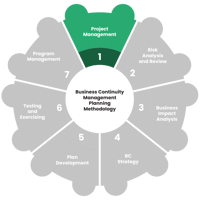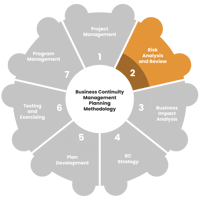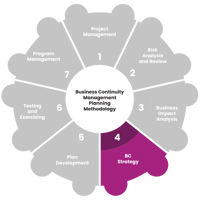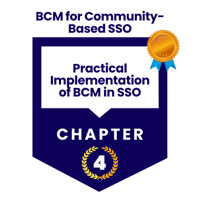Chapter 3
Building a Practical BCM Framework for Social Service Organisations
![[BCM] [SSO] [C3] Building a Practical BCM Framework for Social Service Organisations](https://no-cache.hubspot.com/cta/default/3893111/879387df-1aee-4517-8d38-fa33138b82ab.png) Social service organisations play a vital role in ensuring the safety, care, and emotional well-being of children, youth, and families in need.
Social service organisations play a vital role in ensuring the safety, care, and emotional well-being of children, youth, and families in need.
However, many of these organisations operate with limited resources and rely heavily on people—dedicated staff, volunteers, and donors.
When disruptions occur — whether from a fire, a disease outbreak, or a staff shortage — the impact can ripple through every aspect of service delivery.
To manage these challenges effectively, organisations need a structured yet practical approach. This is where a Business Continuity Management (BCM) framework comes in.
Understanding the BCM Framework
A BCM framework provides the foundation for building resilience and ensuring that essential services can continue even during unexpected disruptions. It offers a step-by-step roadmap that organisations can adapt to their size, complexity, and mission.
The globally recognised standard, ISO 22301: Business Continuity Management Systems, outlines best practices for establishing, implementing, and maintaining continuity plans.
While ISO 22301 was initially developed for commercial organisations, its principles can be easily simplified and adapted for non-profit and social service contexts.
The key is to focus on what matters most: protecting people, maintaining care services, and sustaining trust with families, regulators, and donors.
Adapting the Framework for Non-Profit and Charity Organisations
Non-profit and community-based organisations may not have dedicated BCM teams or large budgets. However, BCM does not need to be complex.
A simplified approach—built around core phases—can be just as effective in ensuring service continuity and preparedness.
Below are the seven core phases of BCM, adapted specifically for social service organisations.
1. Project Management and Sponsorship
 Every successful BCM program begins with leadership commitment.
Every successful BCM program begins with leadership commitment.
The Board or senior management must understand that BCM is not just a compliance exercise—it’s an ethical responsibility to the people under care.
Key actions:
- Appoint a BCM Champion or Coordinator.
- Define the scope of the program (e.g., residential homes, therapy centres, helplines).
- Secure management approval for the BCM plan and allocate minimal but focused resources.
Leadership buy-in signals to staff that continuity planning is a shared organisational priority.
2. Risk Analysis and Review (RAR)
 This step involves identifying potential threats that may disrupt operations.
This step involves identifying potential threats that may disrupt operations.
These can range from physical risks (fire, floods, power outages) to operational risks (IT failures, staff shortages) to reputational risks (data breaches or safety incidents).
Key actions:
- List possible threats and assess their likelihood and potential impact.
- Focus on risks that could directly affect client safety or essential services.
- Collaborate with staff who understand day-to-day operations—they often spot practical risks that management might overlook.
3. Business Impact Analysis (BIA)
 The BIA helps organisations determine which services are most critical and how long they can be interrupted before harm occurs.
The BIA helps organisations determine which services are most critical and how long they can be interrupted before harm occurs.
For example:
- Residential care homes require 24/7 continuity.
- Therapy sessions may tolerate short pauses but must resume quickly to avoid regression.
- Counselling hotlines are essential for mental health crises and must be restored within hours.
Key actions:
- Identify essential services and supporting resources (people, facilities, systems, vendors).
- Determine acceptable downtime for each service.
- Prioritise services based on their importance to client safety and well-being.
4. BC Strategy Development (BCS)
 Once critical services are identified, develop strategies to maintain or quickly recover them during disruptions.
Once critical services are identified, develop strategies to maintain or quickly recover them during disruptions.
Examples of practical strategies:
- Alternate sites: Partner with nearby centres or schools for temporary relocation.
- Remote delivery: Use tele-therapy or online counselling when physical sessions are disrupted.
- Staff redeployment: Cross-train employees so essential roles can be covered in their absence
- Supplier partnerships: Secure backup vendors for food, medicine, and utilities.
The goal is to find realistic and achievable solutions, not perfect ones.
5. Plan Development (PD)
 This phase focuses on documenting all the response and continuity procedures clearly and concisely.
This phase focuses on documenting all the response and continuity procedures clearly and concisely.
Plans should include:
- Contact lists of the staff, parents, and partners.
- Step-by-step procedures for evacuation, relocation, or remote service delivery.
- Communication templates for informing families and donors.
BC plans should be simple, accessible, and easy to follow—especially during a stressful crisis.
6. Testing and Exercises (TE)
 Plans only work if people know how to use them. Testing builds confidence and reveals gaps.
Plans only work if people know how to use them. Testing builds confidence and reveals gaps.
For social service organisations, testing doesn’t have to be complicated.
- Conduct fire drills with residents and staff.
- Run tabletop exercises where teams walk through a hypothetical disruption.
- Test your communication tree to ensure everyone can be reached.
The aim is to cultivate readiness through learning, not to achieve perfection.
7. Program Management (PgM)
 BCM is a continuous process, not a one-time project. After each drill, incident, or change in operations, the plan should be reviewed and updated.
BCM is a continuous process, not a one-time project. After each drill, incident, or change in operations, the plan should be reviewed and updated.
Key actions:
- Conduct annual reviews and refresher training.
- Assign responsibility for monitoring and updating the BCM plan.
- Integrate BCM discussions into regular management meetings.
When BCM becomes part of the organisation’s culture, resilience grows naturally over time.
Bringing It All Together
By following these seven phases, social service organisations can build a BCM program that is both practical and sustainable. It helps ensure that even in the face of crises, care continues, children remain safe, and trust endures.
In the next part of this series, we’ll explore how to implement BCM in community-based settings—including realistic examples of how social service agencies in Singapore can apply these steps in day-to-day operations.
More Information About Business Continuity Management Courses

 To learn more about the course and schedule, click the buttons below for the BCM-300 Business Continuity Management Implementer [B-3] course and the BCM-5000 Business Continuity Management Expert Implementer [B-5].
To learn more about the course and schedule, click the buttons below for the BCM-300 Business Continuity Management Implementer [B-3] course and the BCM-5000 Business Continuity Management Expert Implementer [B-5].
![Register [BL-B-3]*](https://no-cache.hubspot.com/cta/default/3893111/ac6cf073-4cdd-4541-91ed-889f731d5076.png) |
 |
 |
 |
 |
 |
![FAQ [BL-B-3]](https://no-cache.hubspot.com/cta/default/3893111/b3824ba1-7aa1-4eb6-bef8-94f57121c5ae.png) |
If you have any questions, click to contact us.
|
 |
 |
 |
 |





![[BCM] [SSO] [C1] BCM for Community-Based Social Services Organisations](https://no-cache.hubspot.com/cta/default/3893111/abcc60b1-a41a-47de-b0d5-84644744d776.png)
![[BCM] [SSO] [C2] Understanding BCM in Social Service Organisations](https://no-cache.hubspot.com/cta/default/3893111/8dbf8f0f-371f-437c-a7d7-ccaff00b9433.png)

![[BCM] [SSO] [C5] Case Study – Fire in a Residential Care Facility](https://no-cache.hubspot.com/cta/default/3893111/f18526eb-1b38-42a2-9c7d-52afe2121435.png)
![[BCM] [SSO] [C6] Governance and Sustainability in BCM](https://no-cache.hubspot.com/cta/default/3893111/fc72acdb-d95e-4823-b7bf-27ce15cc7542.png)
![[BCM] [SSO] [C7] Conclusion – Building a Culture of Care and Continuity](https://no-cache.hubspot.com/cta/default/3893111/b5cd16e6-e11f-4b42-8349-e043bab8187e.png)
![Email to Sales Team [BCM Institute]](https://no-cache.hubspot.com/cta/default/3893111/3c53daeb-2836-4843-b0e0-645baee2ab9e.png)

